The Wildlife Struggle
Article & Photos by Lauren Svatek
Cartoon by Jerry Cogan
Our communities of Vicksburg Village, Olympia Estates, Lake Shore Harbour, and Dry Creek Village have grown exponentially over several years. Each of these developments were once wooded areas and grassland. They are within the MUD districts of 47 and 48 and include drainage channels and detention ponds serving the communities. Very few wooded areas remain in the area and are likely to be gone within the next few years with continued development. Only Kitty Hollow Park remains as an uninterrupted area for recreation and wildlife habitation.
Wildlife struggles in our urban areas. Over the years, deer and other wildlife have been forced to move to other areas in order to survive or stay and exist in a smaller and smaller habitat. Food, water, shelter and an appropriate habitat are what they need to survive.
People are divided on their feelings about wildlife. Some value it and want to protect it. Some fear it as a threat, nuisance, or menace to their lives and property. Others are indifferent to its presence. Whatever your opinion is, it is necessary to find a way to coexist with the wildlife in our area; our wildlife diversity is one of the great benefits of living in Texas.
Urban growth has put wildlife at a great disadvantage. Compare it to baseball. There are 162 games in a baseball season and great teams will win a majority of their games. However, even the worst of the teams will win games even when competing with the best of teams. Unfortunately, the teams with an abysmal record have no chance of making it to the post season. This is the plight of wildlife in our community. Humans will dominate and wildlife will struggle.
Wildlife provides benefits to our ecosystem. Many urban animals are predators of insect pests. They also provide a check and balance of certain populations of animals that could overrun an area. Remember years when there were too many squirrels? Studies indicate that there is a physical and psychological benefit to humans when they are exposed to wildlife. Along our trails, numerous runners, walkers and dog-walkers comment on different wild animals they see and often take particular paths so that they can see this varied wildlife.
People are responsible for many of the disadvantages that wildlife faces. Since we have forced the wildlife into a small, compact area, we still intrude upon what they have left by leaving designated trails. We pollute the area with trash and debris. We endanger our own pets by letting them roam free. Outdoor cats cause harm and death to small wild animals and birds. Dogs should never be off leash. Both domesticated and wild animals can clash when not properly supervised by their owners. Careless and negligent fishing harms and kills wildlife. All fishing requires a license and proper tagging of fishing lines. Keep in mind that wildlife prefers to be left alone and everyone should keep their distance.
A conversation with one of our Texas Parks and Wildlife–Fort Bend County Game Wardens provided some perspective on the human versus wildlife situation. He provided a number of suggestions to help people coexist with wildlife and provide protection of our wildlife along our trails.
ALLIGATORS – Alligators are a protected species. Feeding, injuring, or harassing alligators is a punishable offense. Game Wardens will assist in determining if an alligator is a nuisance. If you are concerned about an alligator located in a drainage channel or detention pond, please contact the Game Warden via the information below. The drainage channels and detention ponds are habitats for the alligators, and they do not pose a danger by merely existing there. Although I have no photos of this incident, I have cut an alligator loose from a fishing line from which he could not escape. Another example of how we impact wildlife without proper consideration.
FISH AND TURTLES – Fish and turtles are not protected unless they are a particular endangered species. Fishing is allowed in the channels with a fishing license and following all regulations for setting lines. It is best to keep in mind that what you put into the water may have effects beyond your intention. Photos show a turtle that I rescued off an illegal line. It was drowning in the water, because it could not move onto the bank. I had to cut a hook out of its mouth and hoped it would survive. There is a variety of fish in the channel including various types of gar. During Hurricane Harvey floods, alligator gars were seen in the channel.
BIRDS – There is a wide variety of birds along our channels. According to the Game Warden, the majority of birds are protected. A walk on the trail on any day, there may be a great blue heron, spoon bills, raptors, and ducks just to name a few. As seen in the photos, humans impact the birds. I released a great blue heron (a large and majestic bird) from a fishing line with instructions on what to do by a Game Warden. It was able to walk away into the trees after it was released. Another way we impact the birds is with our trash as seen in the photo of the duck with her ducklings next to paper trash.
COYOTES – The coyotes that have appeared along our trails have sparked a lot of conversation. Many people have very particular opinions about the animals. Much of what has been expressed is fear of them and retaliation against them along with a more tempered demonstration of fascination and appreciation. Per our local Game Warden, coyotes are not protected, but are unlikely to leave their habitat to venture into our neighborhoods. They have existed in this wooded area for more years than I have lived here and fluctuated in numbers over all those years. I mentioned that we used to also see bobcats in the same area but thought they might be gone. He said that they are probably still there, they are just not seen. There are many animals in those trees that we may not know exist at all. Here are some of the Game Warden’s tips regarding coyotes in the area:
- Attempt NO interaction with them at all and they most likely will never cross into the neighborhood.
- Keep trash cans covered and pets indoors.
- Do not leave food outdoors for any animals.
- Under NO circumstances should individuals take it upon themselves to capture or kill the animals while on the trail.
If you are concerned about a coyote in the area, please contact the Game Warden via the information below.
This article has highlighted many of the animals on our trails. Not all are included such as deer, raccoons, rabbits and others. There is a great amount of wildlife just outside our door to appreciate and enjoy—from a distance. Also, Kitty Hollow Park is just a walk or drive away where these same animals reside.
Below are some wildlife resources:
- Article written in 2021 and available on the District’s website, “The Wild Alligators Among Us”.
- Article in the Summer 2023 Vicksburg Voice on “Please Leave the Wildlife Alone”.
- The Texas Parks and Wildlife June 2023 article, “Alligators—More Than Just a Pretty Smile” which you can find and subscribe to here. https://content.govdelivery.com/accounts/TXPWD/bulletins/360dd35.
If you capture some photos while out on the trail of animals or plants or water, please share with me at lsvatek@fbmud47.org. Some photos may be suitable for our trail photo gallery, and you will be contacted if considered. (Photos need to be taken with your phone horizontally and sent in actual size by email.) Happy Trails!
To Report incidents, concerns, or disturbances regarding wildlife along the trail:
TX Game Warden Law Enforcement Offices, Austin TX
Dispatch Center: (512)389-4848
The local Game Warden will be contacted with the report.


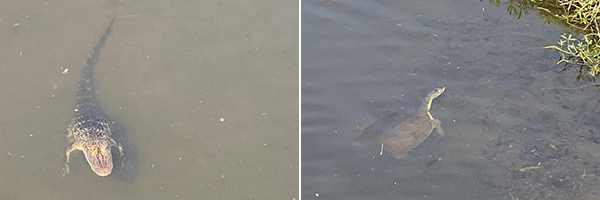
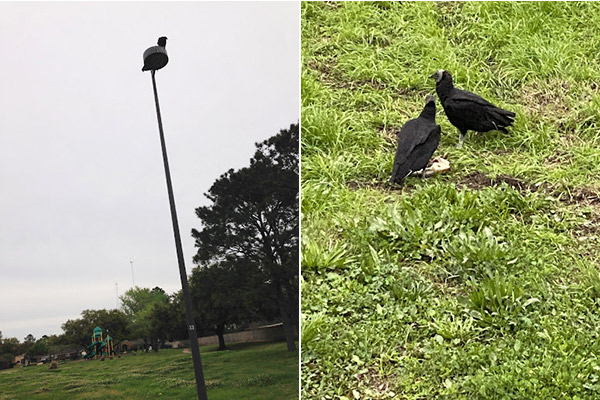
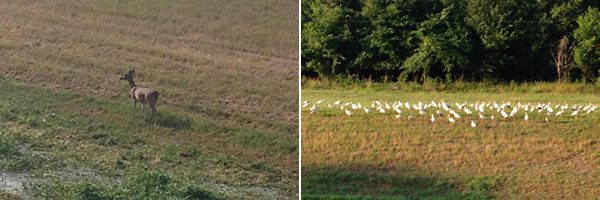
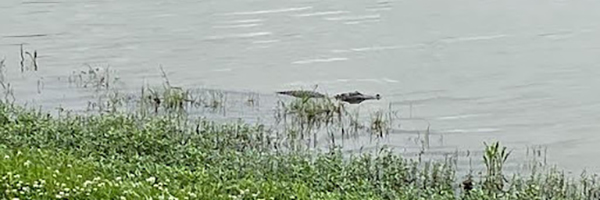
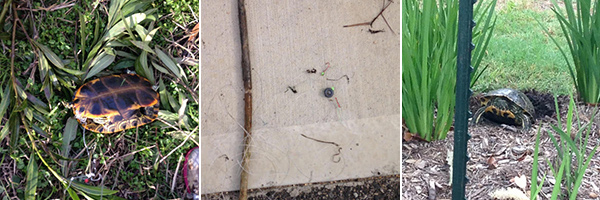


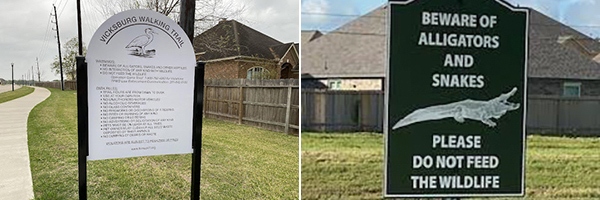

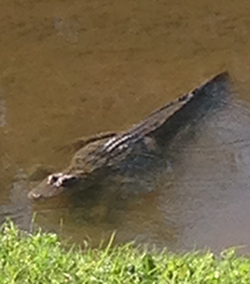 Since humans and alligators share a common space, it is critical for us to be educated about them so that we are able to co-exist with them safely.
Since humans and alligators share a common space, it is critical for us to be educated about them so that we are able to co-exist with them safely. Alligators mate during late spring and early summer. During this time you will generally see more movement from the alligators along drainage channels within and near the District. Female alligators will lay from 15-60 eggs in a mound composed of grass, cattails and mud. Decomposing mounds of vegetation should always be avoided as this could be a nest and the female will be highly protective of the area. Eggs usually hatch around late August or early September. Babies measure approximately 8-9 inches and will be protected by their mother for up to 2 years. Although they may appear “cute” and harmless, it is wise not to approach them as the mother is usually very close and very protective.
Alligators mate during late spring and early summer. During this time you will generally see more movement from the alligators along drainage channels within and near the District. Female alligators will lay from 15-60 eggs in a mound composed of grass, cattails and mud. Decomposing mounds of vegetation should always be avoided as this could be a nest and the female will be highly protective of the area. Eggs usually hatch around late August or early September. Babies measure approximately 8-9 inches and will be protected by their mother for up to 2 years. Although they may appear “cute” and harmless, it is wise not to approach them as the mother is usually very close and very protective. You cannot determine the sex of an alligator by simply looking at them. Males at age 10 average about 8 feet and females of the same age average a little over 6 feet. You can almost be sure that an alligator over 10 feet is a male. Alligators about the size of 4-5 feet are usually travelers as they are expanding their territories away from larger alligators. You can estimate the size of an alligator by judging how many inches there are between the nose and eyes; i.e. 4 inches is about a 4 foot alligator.
You cannot determine the sex of an alligator by simply looking at them. Males at age 10 average about 8 feet and females of the same age average a little over 6 feet. You can almost be sure that an alligator over 10 feet is a male. Alligators about the size of 4-5 feet are usually travelers as they are expanding their territories away from larger alligators. You can estimate the size of an alligator by judging how many inches there are between the nose and eyes; i.e. 4 inches is about a 4 foot alligator.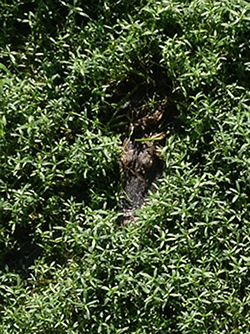 Alligators do blend in with their surroundings and wait for food. Small alligators eat spiders, insects, minnows, shrimp, and crabs. As they grow, their diet may include small fish, turtles, snakes and small birds. The larger they get, the variety and size extends to large turtles, wading birds, ducks, nutria, otters, raccoons, wild boar, and occasionally deer. Carrion is also a favorite, easy accessible food.
Alligators do blend in with their surroundings and wait for food. Small alligators eat spiders, insects, minnows, shrimp, and crabs. As they grow, their diet may include small fish, turtles, snakes and small birds. The larger they get, the variety and size extends to large turtles, wading birds, ducks, nutria, otters, raccoons, wild boar, and occasionally deer. Carrion is also a favorite, easy accessible food. Notably, alligators may lie on the bank of a lake, bayou or channel to bask in the sun. This is a natural behavior and does not indicate aggression. An alligator will hiss as a warning that you are too close. Beware that they can move at bursts of speed of 35 mph on land. They are capable of staying underwater for almost 30 minutes at a time so if you see bubbles moving in the water, it is possible that is an alligator.
Notably, alligators may lie on the bank of a lake, bayou or channel to bask in the sun. This is a natural behavior and does not indicate aggression. An alligator will hiss as a warning that you are too close. Beware that they can move at bursts of speed of 35 mph on land. They are capable of staying underwater for almost 30 minutes at a time so if you see bubbles moving in the water, it is possible that is an alligator.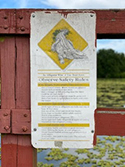 Following these simple rules, understanding their behavior, and having respect for the wild alligators are the best way to protect ourselves and our wildlife. There are several signs in Kitty Hollow Park, which is a great place to observe alligators, with safety rules regarding alligators. The signs remind us that alligators are smart, that we should be smarter than alligators and to always be careful and safe!
Following these simple rules, understanding their behavior, and having respect for the wild alligators are the best way to protect ourselves and our wildlife. There are several signs in Kitty Hollow Park, which is a great place to observe alligators, with safety rules regarding alligators. The signs remind us that alligators are smart, that we should be smarter than alligators and to always be careful and safe!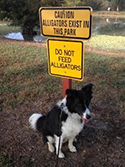 Texas Parks and Wildlife Department has suggested rules when encountering and observing alligators that we have posted along with this article.
Texas Parks and Wildlife Department has suggested rules when encountering and observing alligators that we have posted along with this article.